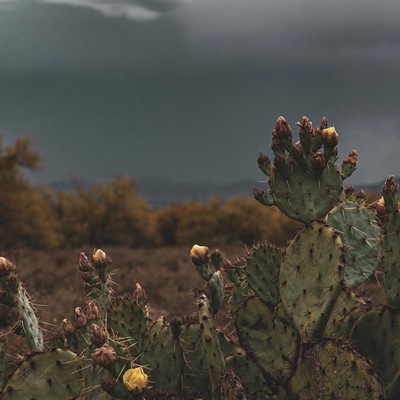During its 750 years of life in the rainy Northwest, this Sitka spruce has grown to a whopping 206 feet; its trunk has bulked up to 56 feet in circumference. But its fence tells a bigger story.
The giant tree, pictured in a photo by Robert Adams, still has its roots in the loamy soil, but it's no longer a wild piece of nature. It's confined to a preserve, Klootchy Creek Park in Oregon, surrounded by a wooden viewing platform and protected behind wooden slats. A lonely survivor of the lost old-growth forest, the mighty Sitka has been reduced to a tourist attraction, a curio that people visit and marvel over, not something they live with.
A big new show at the Center for Creative Photography, Robert Adams: Turning Back: A Photographic Journal of Re-Exploration, is a long lament for the ancient American woods, now vanished. The 164 black-and-white photos were all taken in Oregon, roughly along the trail explored by Lewis and Clark some 200 years ago. But only a few show any of the centuries-old trees that once covered the region's hills and plains.
In one photo, another Sitka spruce, in another state park called Cape Blanco, has a magnificent canopy, with branches spread regally out beyond the edges of the photo paper. It's in a real forest, among trees of varying ages and a mulchy earth floor covered with nurturing needles and bark. In another, Adams' wife, Kerstin, luxuriates in the sun-dappled space beneath a sheltering ponderosa pine.
These surviving giants are the kinds of trees Lewis and Clark marveled over when they first saw the Pacific Coast Range during their epic expedition of 1804-1806.
"The mountains are covered with a very thick growth of timber," Meriwether Lewis wrote in his diary. The trees, he noted, were a stout 8 to 12 feet in diameter, and rose to a height of 210 feet.
Adams tells us that the early settlers who lived in these woods would speak of going "outside" whenever they left its welcoming embrace; "inside," they enjoyed filtered light and the scent of vanilla. His elegiac photos (most of them untitled) chronicle what replaced this forest primeval.
In photo after photo, we see the new forests planted by corporations, their skinny trunks lined up in orderly rows, the better to be clear-cut at a young age in the interests, he writes in a text, of "short-term profits." (And in the interests, it must be said, of a nation of insatiable consumers.) None of these farmed trees are allowed to reach the grand old age of the seven-centuries-old Sitka at Klootchy Creek. Most don't get past the age of 30.
And dozens of mournful pictures record the aftermath of the logging companies' routine arboreal slaughter. Huge swathes of denuded hillsides are littered with the trees' leavings, their dead branches, splintered sticks and truncated stumps strewn carelessly about. No matter where Adams turns his camera--to a long view of stripped slopes, to a close-up of dead stump, to portraits of the wrecking machines that do the damage--he finds nothing less than a sylvan holocaust.
Born in 1937, Adams made his reputation as a photographic chronicler of the new Western landscape, of the shopping malls and subdivisions that have encroached on the monumental spaces recorded by the expedition photographers that came after Lewis and Clark. In one series, for instance, he pictured the suburban sprawl choking Denver. Transplanted from New Jersey to Colorado to Oregon, Adams decided on the new project as the anniversary of the Lewis and Clark expedition approached.
He would follow the explorers' trail through Oregon, but backwards, from west to east. He started at the beach where the weary explorers exulted over the mighty Pacific, then it was eastward ho over the Cascade Range and down into the high desert. One local wag named Adams' turnabout scheme the Clark and Lewis Expedition, but the photographer's west-to-east plan has a serious philosophical underpinning.
It's easier to explore than it is to go home, says the traveling show's organizer, Sandra S. Phillips, the curator of photography at the San Francisco Museum of Art, in her exhibition notes. It's harder to build a life than it is to roam. (Lewis famously fell into a depression and committed suicide after his great adventure.) And Adams' "gesture of turning back, of looking at what has happened, is the metaphor (he) uses in making these pictures," Phillips notes.
A lovely opening photo shows a group of tourists on empty Clatsop Beach, perusing the historical markers that detail Lewis and Clark's arrival. Marooned on a sand dune, they're looking out, looking back, pondering, perhaps, where they've come from, and what has happened to America. The rest of the show answers the question.
If America's virgin forest did not commit environmental suicide, a parallel to Lewis' personal suicide, Americans eagerly helped it toward a premature death. But that was foreseen from the start. Thomas Jefferson sent the expedition out not just to explore and to learn, but to pave a path for commerce. And the nation eagerly responded.
One of Adams' photos depicts a 1905 grave in Pioneer Cemetery in Bandon, Ore. In it lies one John M. Conrad, a 38-year-old member of Woodsmen of the World. Conrad was so proud of his work chopping down the old-growth forest that his loved ones marked his grave not with a standard tombstone, but with a tree stump realistically sculptured in metal. The stump, analog to the wooden carcasses Conrad and others left all over the Northwest, stands proudly in a landscape nearly emptied of trees.
And yet, Adams still finds room for joy. His meditative show is arranged like an oratorio, divided into cantos. The prologue at the beach and the early pictures of the sylvan survivors are followed by passages of mass death and destruction. But the finale hints at redemption.
At the end of their trip, the Adamses happened upon a generous woman in eastern Oregon who invited them to stay on her land, a well-cared-for Eden of apple trees and cottonwoods. Adams' loving pictures of her little piece of paradise exhort us to consider an alternative: not just to cultivate our own gardens, but to cherish and preserve the earth.














